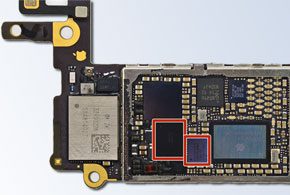New plaintiffs have joined a class action complaint against Apple, claiming the so-called “Touch Disease” has infected their iPhone 6 and 6 Plus smartphones and accusing Apple of violating a long list of consumer protection, deceptive trade loss and warranty acts.
The original suit, filed Aug. 27 in a Northern California U.S. District Court, named three plaintiffs, who the document said were also filing “on behalf of others similarly situated.” An updated suit, filed Oct. 7, names 12 plaintiffs, plus “others similarly situated,” and includes the intentions of “9,539 class members who have experienced the Touchscreen Defect described herein.”
Their suit arises, the document states, from “Apple’s concealment of a material manufacturing defect that ultimately causes iPhone touchscreens to become unresponsive and fail for their essential purpose as smartphones.”
Aka, Touch Disease.
The latter made headlines in August, when repair site iFixit took apart iPhone 6 and iPhone and 6 Plus handsets and offered a prognosis—described by iPhone users across numerous Apple and repair forums—for the gray bar that appeared across the top of iPhone screens and was soon after followed by increasingly glitchy touch functionality and finally no functionality at all.
The problem isn’t touch-screen-related, according to iFixit’s Julia Bluff, but instead has to do with two touch-screen controller chips, or Touch ICs, on the logic board.
“These two chips translate your finger mashing on the display into information your phone can actually use,” she explained. “When the Touch IC chips go bad, you can jab … all you want—your phone can’t correctly process the information.”
Twisting, flexing and lightly bending an iPhone—or, what tends to happen when one is frequently put in a back pocket—is enough to cause the chips to disconnect from the logic board, she added.
The suit charges that Apple has known about the Touch Disease design defect but has “routinely refused to repair the iPhones without charge when the defect manifests.”
As a result, it continued, “owners of the iPhones … have suffered an ascertainable loss of money and/or property and/or value. The unfair and deceptive trade practices committed by Apple were conducted in a manner giving rise to substantial aggravating circumstances.”
One plaintiff, Todd Clearly, contacted Apple about the unresponsive iPhone and was told that he could upgrade to the newest iPhone for $350.
“Mr. Clearly was in the middle of a business transaction and needed a smartphone that worked properly, so Mr. Clearly purchased a Samsung Galaxy S7 and discontinued using his iPhone 6 Plus,” states the suit.
The suit goes on to explain how the other plaintiffs faced similar issues and similar fees.
It also alleges that Apple “failed to adequately research, design, test and/or manufacture the iPhones before warranting, advertising, promoting, marketing and selling the iPhones,” and that “had consumers known of the defect, they would have paid less for the iPhones … or would not have purchased the iPhones at all.”
The plaintiffs are asking for Apple to be required to repair, recall and/or replace the iPhones, for monetary relief, for attorneys’ fees and costs, for any other relief that a court deems appropriate and for a trial by jury.
Apple didn’t immediately respond to a request for comment.
